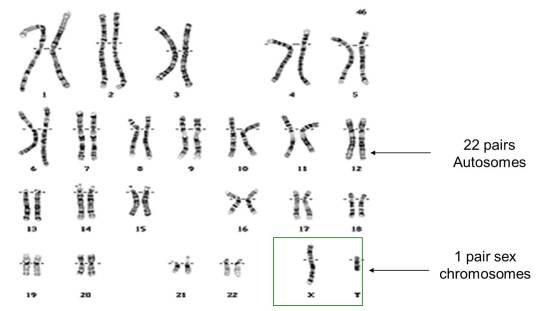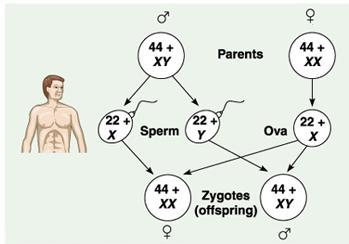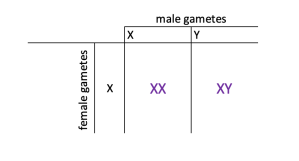Tagged: male
Chromosomes and Sex: Grade 9 Understanding for IGCSE Biology3.26 3.27
Having spent the last day or two writing material about one of the hardest topics in the IGCSE Biology specification (DNA and Protein Synthesis), I am going to write today about something much simpler. You need to understand how the sex of a human is determined at the moment of fertilisation. But this is a topic which can confuse students so I am going to try to explain it for you as best I can.
The sex of a human (whether male or female) is determined by the 23rd pair of chromosomes. Please remember that just because humans determine their sex this way, this doesn’t mean that other species have to be the same. In fact other species use a variety of ways to ensure the correct proportion of male and offspring are born.

As you can see from the picture above, the 23rd pair of chromosomes in humans are called the sex chromosomes. The person whose chromosomes are shown above is male because he has one X and one Y chromosome in his 23rd pair. If we looked at a picture of a human female set of chromosomes, pairs 1 to 22 would be exactly as above, but the 23rd pair would be different. There would be two large X chromosomes rather than one large X and one tiny Y chromosome as shown above.
So a human female has XX as her 23rd pair of chromosomes, a human male has XY as his 23rd pair.
Gametes (Sperm and Egg cells) are made in a process called Meiosis. Remember that meiosis produces daughter cells that are haploid (this means they only have one member of each pair of chromosomes and so half the genetic material)
When a female cell undergoes meiosis in her ovary, the daughter cells produced (egg cells) will contain one of each of the 23 pairs of chromosomes. For the 23rd pair this will always be an X chromosome since both chromosomes in the 23rd pair are X chromosomes.
When a male cell undergoes meiosis in the testis, the daughter cells produced (sperm cells) will contain one of each of the 22 pairs of chromosomes exactly as above. But the 23 pair are different to each other and so half the sperm cells will contain an X chromosome as the 23rd chromosome and half the sperm cells will contain a Y chromosome as the 23rd chromosome.

If you understand the picture above, you understand sex determination in humans. You also need to be able to draw a genetic diagram to show this.
Phenotype: Mum Dad
23rd pair: XX XY
Gametes: X ½X ½Y
Fertilisation:

Offspring 23rd pair of chromosomes: ½ XX and ½ XY
Offspring phenotypes: ½ female and ½ male
Male Reproductive Systems: Grade 9 Understanding for IGCSE Biology 3.8
I am slightly wary about writing about the male and female reproductive systems. Not because I get embarrassed with this topic (5 terms of human dissection at medical school removed any squeamishness about body parts….) But rather that I worry that the school’s internet filters might start blocking my website if the wrong words appear. But you don’t know until you try, so here goes…..
Male Reproductive System
I will start with the male reproductive system as males are simpler than females in many, many ways… The male reproductive system has three functions:
- to produce the male gametes, sperm cells, at a prodigious rate
- to make the male sex hormone testosterone
- to act as a delivery system to ensure sperm cells are carried into the female reproductive tract in conditions that will allow them to fertilise an egg
The first two functions listed above happen in the testis. There are cells in the testis that secrete the hormone testosterone into the blood from puberty onwards. Testosterone switches on secondary sexual characteristics in the male (body hair growth, muscle development, change in pitch of voice etc.) after puberty. The main part of the testis is made up of very long coiled tubules called seminiferous tubules in which the sperm cells are made.
Humans have over a hundred meters of seminiferous tubules in total in both testes and this allows sperm cells to made at a very fast rate. Even though it takes around 75 days to make an individual sperm cell, the testes make them at a rate of around 85 million sperm cells per day. The epididymis is found next to the testis in the scrotum and is a coiled tube in which sperm cells continue to develop and mature. Sperm are stored here too in readiness for ejaculation.
Everyone knows that in humans the testes are found outside the body cavity in order to keep them cool. Sperm production happens at a maximal rate 3 degrees below core body temperature and having testes outside the body keeps them at this temperature.
The vas deferens is a tube lined with smooth muscle that carries sperm cells away from the testis for ejaculation. As you can see it loops around the back of the bladder, before joining up with the urethra just below the bladder. The urethra is the tube that carries urine away from the bladder but can also carry semen once the vas deferens has joined with it.
There are three accessory glands in the male system (prostate gland, seminal vesicle and the Cowpers‘ glands) These glands produce the fluid that when mixed with the sperm cells is called semen. Semen contains a sugar fructose to provide energy for the sperm cells to swim. It is slightly alkaline to neutralise the acidity in the vagina and also contains mucus to make the fluid easy to move along the tubes.
The sperm cells only acquire the ability to swim when in the epididymis and only become totally mature and able to fertilise the egg right next to the egg cell in the female tract.
The penis is an organ that contains erectile tissue that can fill with blood to allow the penis to fit into the female vagina for ejaculation.




